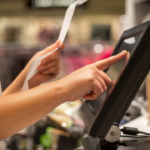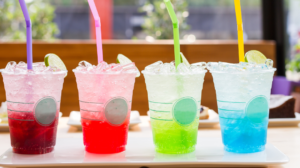Are you literally leaving money on the table? If your servers are not trained in customer service selling techniques, it’s highly likely. Suggestive selling has a bad reputation as “would you like fries with that?” but it is actually beneficial for everyone involved.
- GUESTS – They experience greater satisfaction with their visit because they experience better customer service which is fully focused on their customized needs and desires.
- SERVERS – Larger tickets means larger tips. Servers walk away with more money at the end of their shift.
- OWNERS – It’s a win-win-win opportunity. Customers are happier and Servers are happier and the restaurant is making larger profits.
You might think of suggestive selling as a “Reverse Jedi Mind Trick.” Remember in Star Wars when Obi-Wan is walking through a village with R2D2 and C3PO and tells the approaching Stormtroopers “These aren’t the droids you’re looking for” when they actually were the droids they were looking for. In your restaurant we’re not using mind tricks from the Force, but engaging with your guests using subtle psychological clues to help guide them into an exceptional dining experience.
#1: No Fear
ACTION: Have the mindset that I will engage with the guest and make the ask.
EXAMPLE: “I am enhancing the guest experience by presenting options that will provide them with their ideal dining experience today.”
BACKGROUND: Unless you were born with natural sales ability, the first thought when someone asks you to ‘sell’ is probaby “I don’t want to be a pushy, sleazy used car salesman.” It’s easy to move past that mindset when you reframe the server-guest interaction from ‘selling’ to ‘educating.’ The guest does not naturally know all the options to customize their meal. Whether it’s a choice between regular syrup or an upgrade to real maple syrup, or an enhancement to add blue cheese crumbles to the top of their steak, what you may view as ‘selling’ is really providing a service by educating the customer about their options, which will allow them to walk away extremely satisfied with your restaurant.
#2: Visualize
ACTION: Use descriptive mouth-watering language to really describe a menu item.
EXAMPLE: “Would you like a side of fresh, grilled asparagus topped with our homemade zesty lemon-butter sauce?”
BACKGROUND: If you had a choice between a bowl of vanilla ice cream or a bowl of creamy double-fold vanilla bean premium ice cream, which would you choose? The funny thing is that they’re the exact same thing but one sounds so much better than the other one. Studies have shown that rich, vivid descriptions can increase the sales of that specific item by 27%. If your guest can close their eyes and fully visualize the offering to the point that their mouth is water based on your verbal description, you have perfected the descriptive upsell.
#3: In The Know
ACTION: Offer a Pairing Option when taking entrée orders.
EXAMPLE: “This Cuban Sandwich pairs perfectly with our crisp Pilsner.”
BACKGROUND: They say knowledge is power but in the case of upselling, knowledge is essential for upsell success. The fastest way to lose the confidence of your guest is when they ask questions that you don’t know the answer to …“Is this Halibut fresh?”… “Uumm, I’ll have to go ask.” Anything you suggest about menu choices after that will be meaningless. You’ve lost all credibility as an expert on the one thing you’re paid to be an expert on – the menu. Guests like to feel that they are in good hands, and when you have taken the time to learn about your menu items and what pairs best with each item, you can speak confidently and earn the immediate trust of the guests that you serve.
#4: Just Because
ACTION: Use the word ‘Because’ to add a reason to your upsell.
EXAMPLE: “Do you want to add Onion Rings because it’s Tuesday?”
BACKGROUND: If you say ‘because’ as you offer an upsell item, it automatically adds a justification to make that additional purchase. That reason might be totally non-sensical or unrelated to the actual dining experience, but the bottom line is that it works.
“Are we starting with cocktails BECAUSE the Broncos won today?”
“Perhaps a Strawberry Lemonade BECAUSE the sun came out?”
“Should we add Avocado BECAUSE you’re wearing a Kermit shirt?”
Studies support the use of ‘Because.’ In one test, up to 93% said yes to the item when presented with a ‘Because,’ versus 60% when presented without a ‘Because.’
#5: Power Lists
ACTION: Have a list of 3 high profit-margin items to suggest for each menu section.
EXAMPLE: “For entrées tonight I really like the Chicken Marsala, Beef Stroganoff or the sautéed Medallions of Beef in Pearl Onion Red Wine sauce.”
BACKGROUND: Everyone connects with Lists. That’s why you see so many list-based posts on the internet… “12 Local Restaurants You Must Try,’’ “3 Ways to Save Money When Traveling,” or “Top 10 Wines for Your Bucket List.”
The numbering on these lists keeps us intrigued so we keep reading, plus our curiosity wants to find out what comes in at number one.
This same power works for upselling. In the pre-shift meeting, the manager should let servers know what 3 items to focus on today. These should be chosen based on being high profit margin items and memorized by everyone to present to the guests.
WHAT OTHERS ARE SAYING:
- The Impact of Upselling to Your Restaurant – Linkedin.com
- How to Train Restaurant Staff to Upsell – ToastTab.com
- Restaurant Upselling: Strategies, Tactics, Dos and Don’ts – TableCheck.com




























